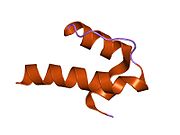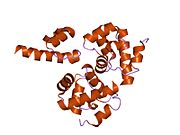Biology:Emerin
 Generic protein structure example |
Emerin is a protein that in humans is encoded by the EMD gene, also known as the STA gene. Emerin, together with LEMD3, is a LEM domain-containing integral protein of the inner nuclear membrane in vertebrates. Emerin is highly expressed in cardiac and skeletal muscle. In cardiac muscle, emerin localizes to adherens junctions within intercalated discs where it appears to function in mechanotransduction of cellular strain and in beta-catenin signaling. Mutations in emerin cause X-linked recessive Emery–Dreifuss muscular dystrophy, cardiac conduction abnormalities and dilated cardiomyopathy.
It is named after Alan Emery.[1]
Structure
Emerin is a 29.0 kDa (34 kDa observed MW) protein composed of 254 amino acids.[2] Emerin is a serine-rich protein with an N-terminal 20-amino acid hydrophobic region that is flanked by charged residues; the hydrophobic region may be important for anchoring the protein to the membrane, with the charged terminal tails being cytosolic.[3] In cardiac, skeletal, and smooth muscle, emerin localizes to the inner nuclear membrane;[4][5] expression of emerin is highest in skeletal and cardiac muscle.[3] In cardiac muscle specifically, emerin also resides at adherens junctions within intercalated discs.[6][7][8]
Function
Emerin is a serine-rich nuclear membrane protein and a member of the nuclear lamina-associated protein family. It mediates membrane anchorage to the cytoskeleton. Emery–Dreifuss muscular dystrophy is an X-linked inherited degenerative myopathy resulting from mutation in the EMD (also known clinically as STA) gene.[9] Emerin appears to be involved in mechanotransduction, as emerin-deficient mouse fibroblasts failed to transduce normal mechanosensitive gene expression responses to strain stimuli.[10] In cardiac muscle, emerin is also found complexed to beta-catenin at adherens junctions of intercalated discs, and cardiomyocytes from hearts lacking emerin showed beta-catenin redistribution as well as perturbed intercalated disc architecture and myocyte shape. This interaction appears to be regulated by glycogen synthase kinase 3 beta.[11]
Clinical significance
Mutations in emerin cause X-linked recessive Emery–Dreifuss muscular dystrophy, which is characterized by early contractures in the Achilles tendons, elbows and post-cervical muscles; muscle weakness proximal in the upper limbs and distal in lower limbs; along with cardiac conduction defects that range from sinus bradycardia, PR prolongation to complete heart block.[12] In these patients, immunostaining of emerin is lost in various tissues, including muscle, skin fibroblasts, and leukocytes, however diagnostic protocols involve mutational analysis rather than protein staining.[12] In nearly all cases, mutations result in a complete deletion, or undetectable levels, of emerin protein. Approximately 20% of cases have X chromosomes with an inversion within the Xq28 region.[13]
Moreover, recent research have found that the absence of functional emerin may decrease the infectivity of HIV-1. Thus, it is speculated that patients with Emery–Dreifuss muscular dystrophy may have immunity to or show an irregular infection pattern to HIV-1.[14]
Interactions
Emerin has been shown to interact with:
- ACTA1,[15]
- ACTG2,[15]
- BANF1,[16][17]
- BCLAF1,[18]
- CTNNB1,[7][19]
- GMCL1,[17]
- LMNA,[15][20][21][22]
- PSME1,[20]
- SYNE1,[23][24][25]
- SYNE2,[23][25][26]
- TMEM43,[27] and
- YTHDC1.[20]
References
- ↑ , pp. 118-119, Wikidata Q29581774
- ↑ "Protein sequence of human EMD (Uniprot ID: P50402)". http://www.heartproteome.org/copa/ProteinInfo.aspx?QType=Protein%20ID&QValue=P50402.
- ↑ 3.0 3.1 "Identification of a novel X-linked gene responsible for Emery–Dreifuss muscular dystrophy". Nature Genetics 8 (4): 323–7. Dec 1994. doi:10.1038/ng1294-323. PMID 7894480.
- ↑ "Emerin deficiency at the nuclear membrane in patients with Emery–Dreifuss muscular dystrophy". Nature Genetics 12 (3): 254–9. Mar 1996. doi:10.1038/ng0396-254. PMID 8589715.
- ↑ "The Emery–Dreifuss muscular dystrophy protein, emerin, is a nuclear membrane protein". Human Molecular Genetics 5 (6): 801–8. Jun 1996. doi:10.1093/hmg/5.6.801. PMID 8776595.
- ↑ "Heart-specific localization of emerin: new insights into Emery–Dreifuss muscular dystrophy". Human Molecular Genetics 6 (13): 2257–64. Dec 1997. doi:10.1093/hmg/6.13.2257. PMID 9361031.
- ↑ 7.0 7.1 "Identification of an emerin-beta-catenin complex in the heart important for intercalated disc architecture and beta-catenin localisation". Cellular and Molecular Life Sciences 67 (5): 781–96. Mar 2010. doi:10.1007/s00018-009-0219-8. PMID 19997769.
- ↑ "Distribution of emerin and lamins in the heart and implications for Emery–Dreifuss muscular dystrophy". Human Molecular Genetics 8 (2): 353–9. Feb 1999. doi:10.1093/hmg/8.2.353. PMID 9949197.
- ↑ "Entrez Gene: EMD emerin (Emery–Dreifuss muscular dystrophy)". https://www.ncbi.nlm.nih.gov/sites/entrez?Db=gene&Cmd=ShowDetailView&TermToSearch=2010.
- ↑ Lammerding, J; Hsiao, J; Schulze, PC; Kozlov, S; Stewart, CL; Lee, RT (29 August 2005). "Abnormal nuclear shape and impaired mechanotransduction in emerin-deficient cells.". The Journal of Cell Biology 170 (5): 781–91. doi:10.1083/jcb.200502148. PMID 16115958.
- ↑ Wheeler, MA; Warley, A; Roberts, RG; Ehler, E; Ellis, JA (March 2010). "Identification of an emerin-beta-catenin complex in the heart important for intercalated disc architecture and beta-catenin localisation.". Cellular and Molecular Life Sciences 67 (5): 781–96. doi:10.1007/s00018-009-0219-8. PMID 19997769.
- ↑ 12.0 12.1 "Emery–Dreifuss muscular dystrophy - a 40 year retrospective". Neuromuscular Disorders 10 (4–5): 228–32. Jun 2000. doi:10.1016/s0960-8966(00)00105-x. PMID 10838246.
- ↑ "Emerin deletions occurring on both Xq28 inversion backgrounds". Human Molecular Genetics 7 (1): 135–9. Jan 1998. doi:10.1093/hmg/7.1.135. PMID 9384614.
- ↑ "Virology: HIV goes nuclear". Nature 441 (7093): 581–2. Jun 2006. doi:10.1038/441581a. PMID 16738646. Bibcode: 2006Natur.441..581L. https://zenodo.org/record/1233237.
- ↑ 15.0 15.1 15.2 "Association of emerin with nuclear and cytoplasmic actin is regulated in differentiating myoblasts". Biochemical and Biophysical Research Communications 303 (3): 764–70. Apr 2003. doi:10.1016/s0006-291x(03)00415-7. PMID 12670476.
- ↑ "The molecular basis of emerin-emerin and emerin-BAF interactions". Journal of Cell Science 127 (Pt 18): 3956–69. Sep 2014. doi:10.1242/jcs.148247. PMID 25052089.
- ↑ 17.0 17.1 "Transcriptional repressor germ cell-less (GCL) and barrier to autointegration factor (BAF) compete for binding to emerin in vitro". The Journal of Biological Chemistry 278 (9): 6969–75. Feb 2003. doi:10.1074/jbc.M208811200. PMID 12493765.
- ↑ "Emerin binding to Btf, a death-promoting transcriptional repressor, is disrupted by a missense mutation that causes Emery–Dreifuss muscular dystrophy". European Journal of Biochemistry 271 (5): 1035–45. Mar 2004. doi:10.1111/j.1432-1033.2004.04007.x. PMID 15009215.
- ↑ "The inner nuclear membrane protein emerin regulates beta-catenin activity by restricting its accumulation in the nucleus". The EMBO Journal 25 (14): 3275–85. Jul 2006. doi:10.1038/sj.emboj.7601230. PMID 16858403.
- ↑ 20.0 20.1 20.2 "Emerin interacts in vitro with the splicing-associated factor, YT521-B". European Journal of Biochemistry 270 (11): 2459–66. Jun 2003. doi:10.1046/j.1432-1033.2003.03617.x. PMID 12755701.
- ↑ "Interaction between emerin and nuclear lamins". Journal of Biochemistry 129 (2): 321–7. Feb 2001. doi:10.1093/oxfordjournals.jbchem.a002860. PMID 11173535.
- ↑ "Direct interaction between emerin and lamin A". Biochemical and Biophysical Research Communications 267 (3): 709–14. Jan 2000. doi:10.1006/bbrc.1999.2023. PMID 10673356.
- ↑ 23.0 23.1 "Nesprins: a novel family of spectrin-repeat-containing proteins that localize to the nuclear membrane in multiple tissues". Journal of Cell Science 114 (Pt 24): 4485–98. Dec 2001. doi:10.1242/jcs.114.24.4485. PMID 11792814. http://jcs.biologists.org/cgi/reprint/114/24/4485.
- ↑ "Nesprin-1alpha self-associates and binds directly to emerin and lamin A in vitro". FEBS Letters 525 (1–3): 135–40. Aug 2002. doi:10.1016/s0014-5793(02)03105-8. PMID 12163176.
- ↑ 25.0 25.1 "Distinct functional domains in nesprin-1alpha and nesprin-2beta bind directly to emerin and both interactions are disrupted in X-linked Emery–Dreifuss muscular dystrophy". Experimental Cell Research 313 (13): 2845–57. Aug 2007. doi:10.1016/j.yexcr.2007.03.025. PMID 17462627.
- ↑ "Nesprin-2 is a multi-isomeric protein that binds lamin and emerin at the nuclear envelope and forms a subcellular network in skeletal muscle". Journal of Cell Science 118 (Pt 4): 673–87. Feb 2005. doi:10.1242/jcs.01642. PMID 15671068.
- ↑ "LUMA interacts with emerin and influences its distribution at the inner nuclear membrane". Journal of Cell Science 121 (Pt 4): 536–48. Feb 2008. doi:10.1242/jcs.019281. PMID 18230648.
Further reading
- "Nuclear assembly.". Annu. Rev. Cell Dev. Biol. 13: 669–95. 1998. doi:10.1146/annurev.cellbio.13.1.669. PMID 9442884.
- "Emery–Dreifuss muscular dystrophy.". Eur. J. Hum. Genet. 10 (3): 157–61. 2002. doi:10.1038/sj.ejhg.5200744. PMID 11973618.
- "Multiple roles for emerin: implications for Emery–Dreifuss muscular dystrophy". The Anatomical Record Part A: Discoveries in Molecular, Cellular, and Evolutionary Biology 288 (7): 676–80. 2006. doi:10.1002/ar.a.20334. PMID 16761279.
- "Transcriptional organization of a 450-kb region of the human X chromosome in Xq28". Proc. Natl. Acad. Sci. U.S.A. 90 (23): 10977–81. 1994. doi:10.1073/pnas.90.23.10977. PMID 8248200.
- "Identification of new mutations in the Emery–Dreifuss muscular dystrophy gene and evidence for genetic heterogeneity of the disease". Hum. Mol. Genet. 4 (10): 1859–63. 1996. doi:10.1093/hmg/4.10.1859. PMID 8595407.
- "A novel emerin mutation in a Japanese patient with Emery–Dreifuss muscular dystrophy". Hum. Genet. 97 (5): 693–4. 1996. doi:10.1007/BF02281886. PMID 8655156.
- "Long-range sequence analysis in Xq28: thirteen known and six candidate genes in 219.4 kb of high GC DNA between the RCP/GCP and G6PD loci". Hum. Mol. Genet. 5 (5): 659–68. 1997. doi:10.1093/hmg/5.5.659. PMID 8733135.
- "Aberrant intracellular targeting and cell cycle-dependent phosphorylation of emerin contribute to the Emery–Dreifuss muscular dystrophy phenotype". J. Cell Sci. 111 (6): 781–92. 1998. doi:10.1242/jcs.111.6.781. PMID 9472006.
- "Immunocytochemical detection of emerin within the nuclear matrix". Neuromuscul. Disord. 8 (5): 338–44. 1998. doi:10.1016/S0960-8966(98)00031-5. PMID 9673989.
- "Changes at P183 of emerin weaken its protein-protein interactions resulting in X-linked Emery–Dreifuss muscular dystrophy". Hum. Genet. 104 (3): 262–8. 1999. doi:10.1007/s004390050946. PMID 10323252.
- "Emerin presence in platelets". Acta Neuropathol. 100 (3): 291–8. 2001. doi:10.1007/s004019900169. PMID 10965799.
- "HA95 is a protein of the chromatin and nuclear matrix regulating nuclear envelope dynamics". J. Cell Sci. 113 (21): 3703–13. 2001. doi:10.1242/jcs.113.21.3703. PMID 11034899.
- "DNA Cloning Using In Vitro Site-Specific Recombination". Genome Res. 10 (11): 1788–95. 2001. doi:10.1101/gr.143000. PMID 11076863.
- "Structural characterization of the LEM motif common to three human inner nuclear membrane proteins". Structure 9 (6): 503–11. 2001. doi:10.1016/S0969-2126(01)00611-6. PMID 11435115.
External links
- GeneReviews/NCBI/NIH/UW entry on Emery–Dreifuss muscular dystrophy
- EMD+protein,+human at the US National Library of Medicine Medical Subject Headings (MeSH)
 |




